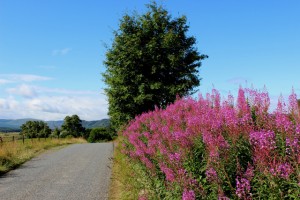 There is so much colour in the wildflowers at this time of the year and so much variation. Purple is one dominant colour and that comes from the various types of thistles and these are very good nectar sources for a variety of butterflies. Meadow browns, small tortoiseshells and common blue butterflies are amongst those that seek out this nectar. The large, sometimes dominant patches of deep pink flowers are mainly from rosebay willowherb and whilst the flowers do not attract butterflies there are many moths that feed on the nectar under the cover of darkness. Yellow flowers often form clumps of the comparatively small flowers of lady’s bedstraw. The larger and more flamboyant ragwort can dominate some areas and, despite its poor reputation as being poisonous to livestock, it attracts a wide range of wildlife. Perhaps one of the best known insects is the striking cinnabar moth as its brightly coloured caterpillars with orange and black bands can often be seen. Ironically the caterpillars have the ability to store the poisons in the ragwort to use as a defence against any predators such as birds.
There is so much colour in the wildflowers at this time of the year and so much variation. Purple is one dominant colour and that comes from the various types of thistles and these are very good nectar sources for a variety of butterflies. Meadow browns, small tortoiseshells and common blue butterflies are amongst those that seek out this nectar. The large, sometimes dominant patches of deep pink flowers are mainly from rosebay willowherb and whilst the flowers do not attract butterflies there are many moths that feed on the nectar under the cover of darkness. Yellow flowers often form clumps of the comparatively small flowers of lady’s bedstraw. The larger and more flamboyant ragwort can dominate some areas and, despite its poor reputation as being poisonous to livestock, it attracts a wide range of wildlife. Perhaps one of the best known insects is the striking cinnabar moth as its brightly coloured caterpillars with orange and black bands can often be seen. Ironically the caterpillars have the ability to store the poisons in the ragwort to use as a defence against any predators such as birds.
Many of these wildflowers can be seen by looking no further than roadside verges that are now widely regarded as some of the last remaining fragments of rich wildlife areas. To get some idea of this is to look at the verges much earlier in the year as spring develops. Then the colours are often dominated by the yellow of primroses and the intense blue of bluebells. Sometimes these can carpet the ground and are an indication that at one time such verges were bordered by old woodland. The point is that bluebells and primroses are indicators of ancient woodland and give a ready idea as to how woodland has been lost in so many areas.
In contrast at this time of the year, the main colours on roadside verges , as I found out last week, are a mixture of purples, pinks, yellows and blues. The pale blue colouring comes mainly from the harebells. Harebell is a misnomer in some ways as in the Highlands this attractive roadside flowers are more often referred to as the bluebell or the Scottish bluebell. The bluebell is, in Scotland, known as the wild hyacinth which seems all very confusing. Very few of these flowers mentioned are dominant but there is one exception on roadside verges and that is the sometimes abundant willowherb. The deep pink, four petalled flowers can form sheets of conspicuous colour. One such areas is on the side of Strathnairn where I photographed them last week. The image shows the broad swathe of willowherb and, typically for a roadside verge, a rowan tree in the background.
Roadside verges have, as far as wildlife is concerned, become important refuges for a wide range of birds, flowers, insects and, to some extent, mammals. In some ways they are similar to gardens. Both gardens and verges are some of the last remnants of the countryside that was once rich in wildlife before intense agricultural methods took over such large tracts of the countryside. The problem with roadside verges is that they need to be treated sympathetically as far as wildlife is concerned. The very worse thing that can happen to them is just what has been taking place in the last couple of weeks or so. Mowing machines from local authorities have been cutting mile after mile of verges which is exactly the wrong time of year. There are guidelines but these are just ignored. Certain stretches, such as bends, do need cutting in the interests of safety but the rest should be left until later after wildflowers have set seed.
